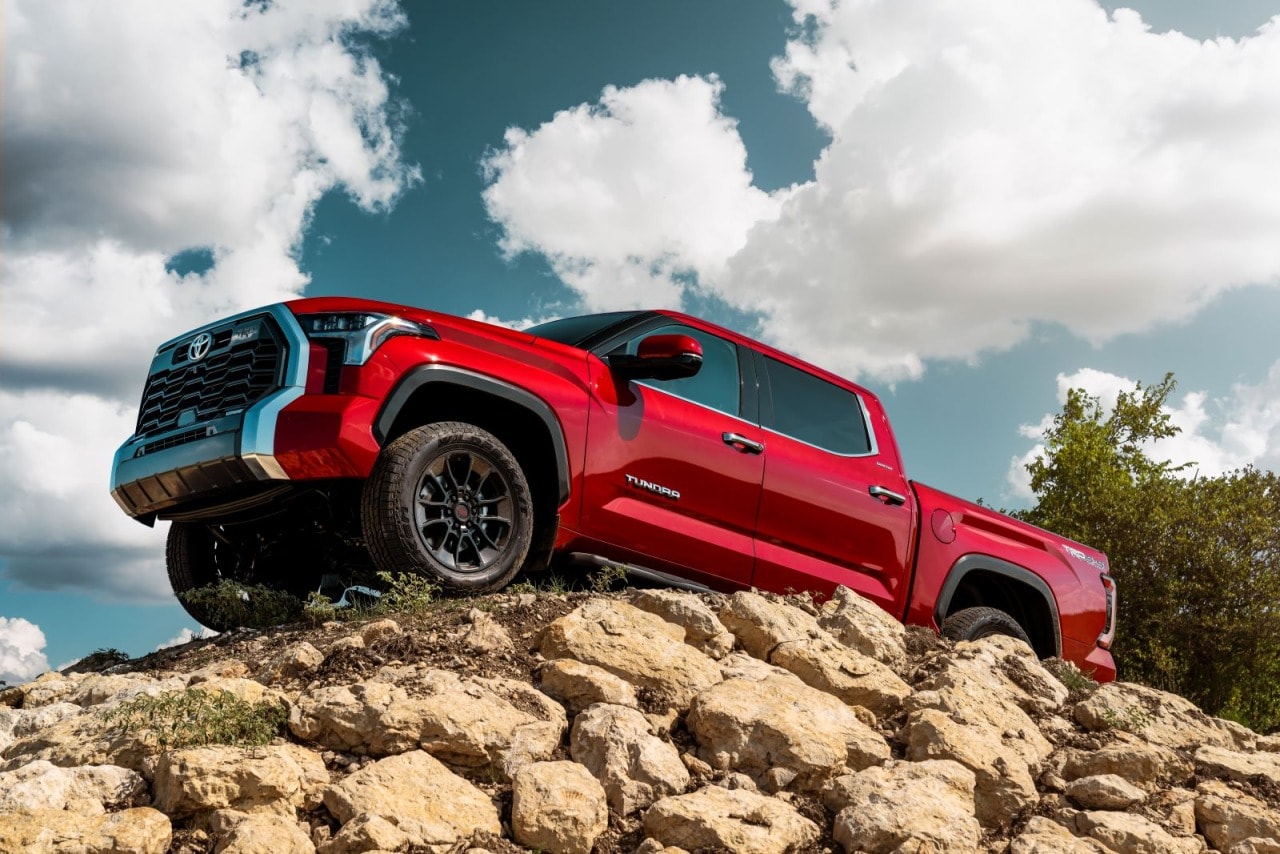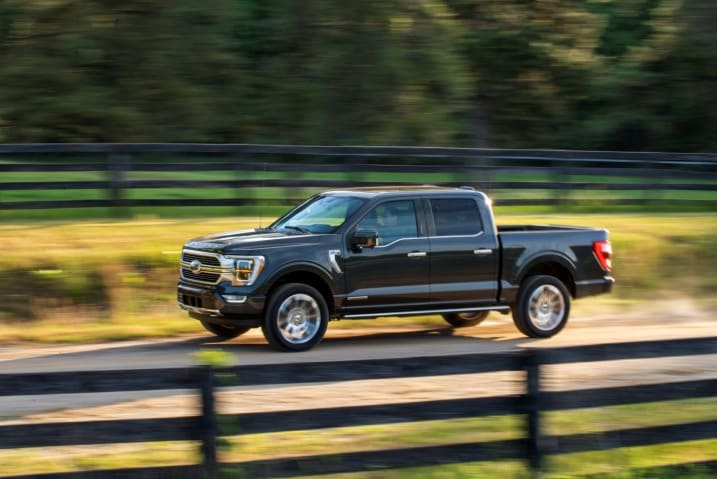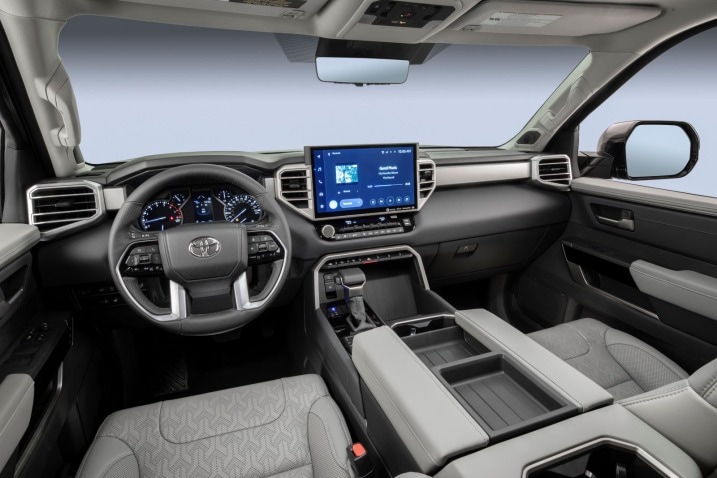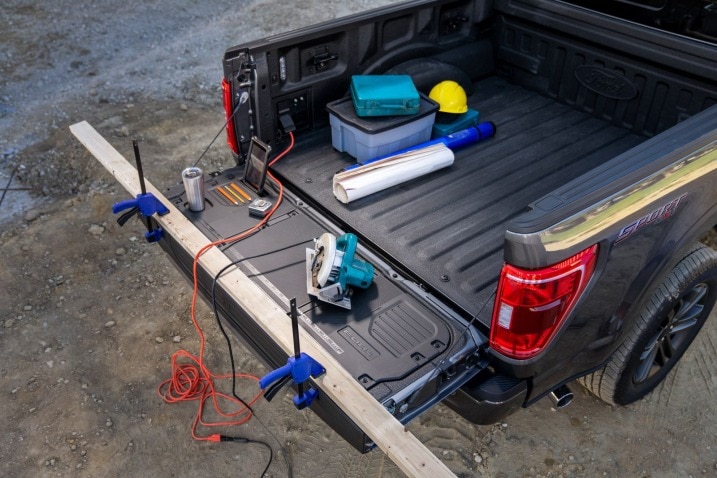- Redesigned 2022 Toyota Tundra makes a splash in all the right ways.
- After its own 2021 redesign, the Ford F-150 offers hundreds of capable variations.
- Both trucks provide spectacular features and capability, but one stands out.
2022 Toyota Tundra vs. 2021 Ford F-150: Matching Up Two Brawny Full-Size Trucks
Toyota's redesigned full-size pickup battles the current champ
The introduction of the Toyota Tundra, fully redesigned for the first time since 2007, has made truck fans across the country stop and take notice. The new pickup features several much-needed improvements including a new lineup of engines, an available 14-inch central touchscreen and loads of standard safety equipment.
But is that enough to give the Tundra an upper hand against its competition? To find out, we took one of the first Tundras available for testing ahead of its launch later this year and pitted it against our top-rated light-duty full-size truck: the Ford F-150. The F-150 tops the class when it comes to maximum towing and payload capacities, but more importantly, it offers a vast number of styles and versions to help shoppers find the perfect truck for their needs.
Putting the Tundra and F-150 side by side allowed us the opportunity to compare them in terms of size, functionality, tech features and more. Whether you're a Ford person at heart or a loyal Toyota customer, this close look at two cutting-edge pickups brings some interesting things to light.
Tundra vs. F-150: Sizes and configurations
Compared with most of its full-size pickup rivals, the Toyota Tundra comes in a smaller selection of sizes and variations. You can choose from an extended Double Cab version or the larger crew cab called CrewMax. The former comes with your choice of a 6.5-foot bed or an 8.1-foot bed, while the latter offers a 5.5-foot bed or a 6.5-foot bed.
There are also six trim levels to choose from. The Tundra SR and SR5 are the base models, followed by the Limited with more standard features. The Platinum trim has luxurious appointments inside and its 1794 relative features rustic ranch themes and accents. Finally, the TRD Pro model is an off-road variant with its own unique set of equipment and styling. The point is to provide the choice that will meet the needs of most customers, without overcomplicating the ordering process.
The Ford F-150 does not worry itself with such matters. It comes in a dizzying number of sizes and styles, beginning with the regular single cab that is becoming increasingly rare in modern trucks. There are also the extended SuperCab style and the larger SuperCrew. All three cab sizes come with your choice of two bed sizes — the regular and SuperCab offer a 6.5-foot or 8-foot bed, while the SuperCrew offers a 5.5-foot or 6.5-foot bed.
There are a lot of trim levels. These range from the basic F-150 XL and XLT to the midlevel Lariat, followed by the opulent King Ranch, Platinum and Limited. Last but not least is the off-road-focused F-150 Raptor. The point here is to provide the right size and style for nearly every conceivable buyer on the market, and it's hard to imagine any company going to greater lengths than Ford does in that respect.
For the purposes of our comparison, we tested a 2022 Tundra Limited crew cab with the 5.5-foot bed and its available TRD Off-Road package, as well as a 2021 Ford F-150 Platinum SuperCrew with its 5.5-foot bed.
Ford F-150
Tundra vs. F-150: Engines and power
The same story continues when we venture under the hood: the simplicity of the Tundra against the complexity of the F-150.
Toyota went with a rather controversial decision in the 2022 Tundra. Instead of V8 power like in the last-generation Tundra, the new model offers one of two turbocharged V6 engines. The first is a twin-turbo 3.5-liter V6 making 389 horsepower and 479 lb-ft of torque. These are substantial figures for any truck, but it's notable that the Tundra offers such muscle as standard equipment. On the road, the turbo V6 feels powerful and smooth, even emitting a low rumble that is fondly reminiscent of larger V8s.
Then there's a second option, which is the same twin-turbo V6 engine paired with a hybrid system that uses onboard batteries and electric motors to increase power and improve fuel economy. That engine, called i-Force Max, produces 437 hp and 583 lb-ft of torque. The i-Force Max hybrid V6 is optional on the Limited, 1794 and Platinum trims, and it also comes standard on the TRD Pro. Both engines are paired with a 10-speed automatic transmission making its grand debut on the 2022 Tundra.
As for the F-150, take your pick. There are traditional engines including a 3.3-liter V6 and a 5.0-liter V8, plus more specialized ones such as a 3.0-liter turbodiesel V6 and a 2.7-liter turbocharged V6. Then there's a turbocharged 3.5-liter V6 making 400 hp and 500 lb-ft of torque, followed by a hybrid version of that same engine called the PowerBoost that makes 430 hp and 570 lb-ft of torque.
Our test F-150 came with the PowerBoost hybrid. We've found this engine not only powerful but extremely smooth thanks to the supplemental electric muscle that is fed into the powerband. This provides the F-150 with plenty of power early in the rev range, and it also helps the truck accelerate and get up to highway speeds quickly. It's an engine that combines old-school power with new-school crispness, and it also boasts the highest EPA fuel economy estimates the F-150 has to offer.
Toyota Tundra
Toyota Tundra vs. F-150: Interior space, comfort and tech
The simple, usable interior inside the Tundra is a big reason why owners liked the previous generation. Sure, it had loads of hard plastic and other cheap-looking materials — but to many, that just meant they weren't afraid to get it dirty. The same concept applies to the new generation, as the 2022 Tundra makes function a top priority. There are large, clearly marked buttons and dials as well as large cupholders. The spacious center bin has a retractable top section so you can easily grab items inside without opening the entire lid.
Drivers and passengers of all sizes should find the interior spacious and comfortable. We tested a Limited trim that came with simulated leather seats that are plenty wide but still hold drivers in place. These seats are quite comfortable and provide excellent support for long trips.
Those shoppers who enjoy tech features will find a lot to like in the Tundra. An 8-inch touchscreen comes standard, and our test vehicle had the optional 14-inch screen with quick response to touch and impressive graphics. Apple CarPlay and Android Auto smartphone integration are not only standard, but they also come wireless on every Tundra trim level. You can also choose an 12.3-inch driver information display with digital instrument gauges, but our tester had the 4.1-inch screen with analog gauges on either side that worked just fine. There are also loads of exterior cameras available, including multiple bird's-eye views, and they look clear on the massive 14-inch screen.
The F-150 is similarly spacious and useful inside, with a few important differences. Firstly, the materials on the Platinum trim vehicle we tested simply outclassed those in the Tundra Limited. The F-150 featured wood, aluminum, leather and other premium materials that put an impressive level of high-grade surfaces on display. As for storage, the F-150 featured the large cupholders and an even bigger center bin than the Tundra, and it also included large door pockets and a covered tray for small items that the Tundra didn't have.
The seats in the F-150 Platinum are swathed in upscale leather and feel plush. They practically wrap around drivers to keep them in place, creating a cozy recliner kind of experience that also provided plenty of support. These seats in the Platinum are also heated and ventilated.
Like the Tundra, the F-150 offers a standard 8-inch touchscreen. Its upgraded screen is a 12-inch unit, standard on the Lariat trim and up, that feels plenty big and offers a nifty split-screen view — so you can keep maps open and still scroll through your music, for example. Apple CarPlay and Android Auto are also standard on all trim levels, and both are wireless whether you have the 8-inch or 12-inch screen. Multiple exterior camera views are also in play, and provided a helpful extra set of eyes while maneuvering the truck at low speeds.
Toyota Tundra
F-150 vs. Tundra: Towing ability and features
There's no doubt about it: Both of these trucks are tough. And each has some tricks up its sleeve. For the Tundra, that's its composite bed. This means the bed in the back of every Tundra is made of a composite material that is resistant to scratching and denting. It's the same material used in the bed of the smaller midsize Toyota Tacoma, and just like with the Tacoma, the innovative bed is standard on all Tundra models.
Some versions of the Tundra are capable of hauling up to 1,940 pounds of maximum payload capacity, and the truck has a maximum towing capacity of up to 12,000 pounds. Both of those numbers are impressive, but neither is threatening to take the class crown. Instead, Tundra fans will be pleased to learn that both figures are improvements over the previous generation, in part due to the fully boxed frame that underlies every truck in the new generation. This helps to improve towing capacity, but it also makes the Tundra more stable and confident whether you're pulling a lot of weight or not.
As for the F-150, it also has a protective bedliner. However, it isn't standard, meaning you'll have to pay if you want it installed. The F-150 uses a different set of tricks — namely, the Pro Power Onboard system, which is a powerful electric generator. This system is optional, and it's available in one of three power outputs: 2 kW, 2.4 kW or 7.2 kW (the latter is only available with the PowerBoost hybrid engine). You can use Pro Power Onboard's household-style outlets to power tools, computers, speakers, or anything else you've brought along for work or fun.
As far as maximum capacities, the F-150 has the game wrapped up in a neat little bow. Some versions boast 3,325 pounds of maximum payload capacity, which is tops in the class. It can also tow up to 14,000 pounds in some configurations, and our F-150 PowerBoost Hybrid Platinum with 4WD posted a maximum rating of 12,400 pounds — or slightly more than the most capable Tundra. This combination of luxury, smart tech and towing know-how is what makes the F-150 worthy of being our top-rated full-size truck.
Ford F-150
Edmunds says
Our biggest takeaway from this Ford F-150 vs. Toyota Tundra comparison is ... that we can't wait to test the Tundra in its hybrid version.
But until then, the redesigned 2022 Tundra gives us a lot to consider. For one thing, it's plenty spacious and provides a comfortable ride. For another, the standard twin-turbocharged V6 engine is certainly not lacking for power. And finally, there are plenty of unique features and capabilities that should make the new Tundra appealing to truck buyers — even in a crowded marketplace where competition is tight. If you're partial to Toyota, the Tundra should only reinforce your loyalty.
On the flip side, we're struggling to find much that the Tundra does better than the F-150. The reigning top-rated truck from Ford simply goes the extra mile, whether we're talking comfort, technology or sheer gut-wrenching power. It nails the basic capabilities that we expect out of every truck, and in many ways sails right past them, from the vast number of variations at your disposal to innovative equipment such as the hybrid powertrain and onboard electric generator.
Toyota has produced an impressive truck with its new Tundra, and the gap between it and the three main domestic full-size truck-makers is smaller than ever. But the pickup wearing the crown is not going to change just yet. While the Tundra now comes with a stronger recommendation than previous years, it's still the F-150 that earns a seat on the throne.
Toyota Tundra










 by
by